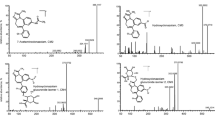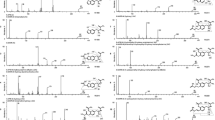Abstract
The first synthetic tryptamines have entered the designer drug market in the late 1990s and were distributed as psychedelic recreational drugs. In the meantime, several analogs have been brought onto the market indicating a growing interest in this drug class. So far, only scarce analytical data were available on the detectability of tryptamines in human biosamples. Therefore, the aim of the presented study was the development and full validation of a method for their detection in human urine and plasma and their quantification in human plasma. The liquid chromatography-linear ion trap mass spectrometry method presented covered 37 tryptamines as well as five β-carbolines, ibogaine, and yohimbine. Compounds were analyzed after protein precipitation of urine or fast liquid–liquid extraction of plasma using an LXQ linear ion trap coupled to an Accela ultra ultra high-performance liquid chromatography system. Data mining was performed via information-dependent acquisition or targeted product ion scan mode with positive electrospray ionization. The assay was selective for all tested substances with limits of detection in urine between 10 and 100 ng/mL and in plasma between 1 and 100 ng/mL. A validated quantification in plasma according to international recommendation could be demonstrated for 33 out of 44 analytes.



Similar content being viewed by others
References
European Commission (2005) Official J EU:L 127:
United Nations Office on Drugs and Crime (UNODC) (2013) The challenge of new psychoactive substances. Global SMART Programme. http://www.unodc.org/documents/scientific/NPS_2013_SMART.pdf, pp. 1–122
Ott J (1996) Pharmacotheon: entheogenic drugs, their plant sources and history. Natural Products, Kennewick
Ott J (2001) Shamanic snuffs or entheogenic errhines. Entheobotanica, Solothurn
Szara S (1970) DMT (N, N-Dimethyltryptamine) and homologues: clinical and pharmacological considerations. In: Efron DH (ed) Psychotomimetic drugs. Raven, New York, pp 275–298
Shulgin A, Shulgin A (1997) Tihkal, the continuation. Transform Press, Berkeley
Shulgin AT (2003) Basic pharmacology and effects. In: Laing RR (ed) Hallucinogens. A forensic drug handbook. Elsevier Science, London, pp 67–137
Nichols DE (2004) Pharmacol Ther 101:131–181
Ray TS (2010) PLoS One 5:e9019
Shulgin AT, Carter MF (1980) Commun Psychopharmacol 4:363–369
Meatherall R, Sharma P (2003) J Anal Toxicol 27:313–317
Vorce SP, Sklerov JH (2004) J Anal Toxicol 28:407–410
Wilson JM, McGeorge F, Smolinske S, Meatherall R (2005) Forensic Sci Int 148:31–36
Tanaka E, Kamata T, Katagi M, Tsuchihashi H, Honda K (2006) Forensic Sci Int 163:152–154
Smolinske SC, Rastogi R, Schenkel S (2005) J Med Toxicol 1:22–25
Shulgin A (2013) www erowid org http://www.erowid.org/chemicals/5meo_dalt/5meo_dalt_info1.shtml
Arunotayanun W, Dalley JW, Huang XP, Setola V, Treble R, Iversen L, Roth BL, Gibbons S (2013) Bioorg Med Chem Lett 23:3411–3415
Corkery JM, Durkin E, Elliott S, Schifano F, Ghodse AH (2012) Prog Neuropsychopharmacol Biol Psychiatry 39:259–262
Martins CPB, Freeman S, Alder JF, Passie T, Brandt SD (2010) Trends Anal Chem 29:285–296
Brandt SD, Martins CPB (2010) Trends Anal Chem 29:858–869
Gaujac A, Navickiene S, Collins MI, Brandt SD, de Andrade JB (2012) Drug Test Anal 4:636–648
Barker SA, McIlhenny EH, Strassman R (2012) Drug Test Anal 4:617–635
McKenna DJ, Towers GH, Abbott F (1984) J Ethnopharmacol 10:195–223
McIlhenny EH, Riba J, Barbanoj MJ, Strassman R, Barker SA (2011) Biomed Chromatogr 25:970–984
Riba J, Valle M, Urbano G, Yritia M, Morte A, Barbanoj MJ (2003) J Pharmacol Exp Ther 306:73–83
Riba J, McIlhenny EH, Valle M, Bouso JC, Barker SA (2012) Drug Test Anal 4:610–616
Callaway JC, Raymon LP, Hearn WL, McKenna DJ, Grob CS, Brito GS, Mash DC (1996) J Anal Toxicol 20:492–497
Hasler F, Bourquin D, Brenneisen R, Bar T, Vollenweider FX (1997) Pharm Acta Helv 72:175–184
Wohlfarth A, Weinmann W, Dresen S (2010) Anal Bioanal Chem 396:2403–2414
Wohlfarth A, Weinmann W (2010) Bioanalysis 2:965–979
Jin MJ, Jin C, Kim JY, In MK, Kwon OS, Yoo HH (2011) J Forensic Sci 56:1044–1048
Katagi M, Kamata T, Zaitsu K, Shima N, Kamata H, Nakanishi K, Nishioka H, Miki A, Tsuchihashi H (2010) Ther Drug Monit 32:328–331
Brandt SD, Tirunarayanapuram SS, Freeman S, Dempster N, Barker SA, Daley PF, Cozzi NV, Martins CPB (2008) J Label Compd Radiopharm 51:423–429
Brandt SD, Freeman S, Fleet IA, McGagh P, Alder JF (2005) Analyst 130:330–344
Brandt SD, Tearavarich R, Dempster N, Cozzi NV, Daley PF (2012) Drug Test Anal 4:24–32
Tearavarich R, Hahnvajanawong V, Dempster N, Daley PF, Cozzi NV, Brandt SD (2011) Drug Test Anal 3:597–608
Wissenbach DK, Meyer MR, Remane D, Weber AA, Maurer HH (2011) Anal Bioanal Chem 400:79–88
Remane D, Meyer MR, Peters FT, Wissenbach DK, Maurer HH (2010) Anal Bioanal Chem 397:2303–2314
Wissenbach DK, Meyer MR, Remane D, Philipp AA, Weber AA, Maurer HH (2011) Anal Bioanal Chem 400:3481–3489
Maurer HH, Wissenbach DK, Weber AA (2013) Maurer/Wissenbach/Weber MWW LC-MSn library of drugs, poisons, and their metabolites. Wiley-VCH, Weinheim
European Medicines Agency (2009) Guidelines for the validation of analytical methods used in residue depletion studies. http://www.ema.europa.eu/docs/en_GB/document_library/Scientific_guideline/2010/01/WC500040499.pdf, pp. 1–19
European Commission (2012) Method validation and quality control procedures for pesticide residues analysis in food and feed. Guidance documents. http://ec.europa.eu/food/plant/protection/resources/qualcontrol_en.pdf, pp. 1–40
European Communities (2002) Off J Eur Commun 221:8–32
Peters FT, Paul LD, Musshoff F, Aebi B, Auwaerter V, Kraemer T, Skopp G (2009) Toxichem Krimtech 76:185–208 (http://www.gtfch.org/cms/images/stories/media/tk/tk76_3/richtlinieanhangb2009-06-01.pdf)
Wille SM, Peters FT, Di-Fazio V, Samyn N (2011) Accred Qual Assur 16:279–292
Scientific Working Group for Forensic Toxicology S (2013) Standard practices for method validation in forensic toxicology. http://www.swgtox.org/documents/Validation3.pdf, pp. 1–52
United Nations Office on Drugs and Crime (UNODC) (2009) Guidance for the validation of analytical methodology and calibration of equipment used for testing of illicit drugs in seized materials and biological specimens. http://www.unodc.org/unodc/en/scientists/guidance-for-the-validation-of-analytical-methodology.html, pp. 1–76
Matuszewski BK, Constanzer ML, Chavez-Eng CM (2003) Anal Chem 75:3019–3030
Shah VP, Midha KK, Findlay JW, Hill HM, Hulse JD, McGilveray IJ, McKay G, Miller KJ, Patnaik RN, Powell ML, Tonelli A, Viswanathan CT, Yacobi A (2000) Pharm Res 17:1551–1557
Peters FT, Hartung M, Herbold M, Schmitt G, Daldrup T, Musshoff F (2004) Toxichem Krimtech 71:146–154 (http://www.gtfch.org/cms/images/stories/media/tk/tk71_3/Peters1.pdf)
Peters FT, Paul LD, Musshoff F, Aebi B, Auwaerter V, Kraemer T, Skopp G (2009) Toxichem Krimtech 76:185–208 (https://www.gtfch.org/cms/files/GTFCh_Richtlinie_Anhang%20B_Validierung_Version%201.pdf)
Viswanathan CT, Bansal S, Booth B, DeStefano AJ, Rose MJ, Sailstad J, Shah VP, Skelly JP, Swann PG, Weiner R (2007) Pharm Res 24:1962–1973
Remane D, Meyer MR, Wissenbach DK, Maurer HH (2010) Rapid Commun Mass Spectrom 24:3103–3108
European Medicines Agency (2011) Guideline on bioanalytical method validation. http://www.ema.europa.eu/docs/en_GB/document_library/Scientific_guideline/2011/08/WC500109686.pdf,
Acknowledgments
The authors like to thank Gabriele Ulrich, Carsten Schröder, and Armin A. Weber for their support as well as Carina Wink and Golo M. Meyer for their help.
Author information
Authors and Affiliations
Corresponding author
Rights and permissions
About this article
Cite this article
Meyer, M.R., Caspar, A., Brandt, S.D. et al. A qualitative/quantitative approach for the detection of 37 tryptamine-derived designer drugs, 5 β-carbolines, ibogaine, and yohimbine in human urine and plasma using standard urine screening and multi-analyte approaches. Anal Bioanal Chem 406, 225–237 (2014). https://doi.org/10.1007/s00216-013-7425-9
Received:
Revised:
Accepted:
Published:
Issue Date:
DOI: https://doi.org/10.1007/s00216-013-7425-9




